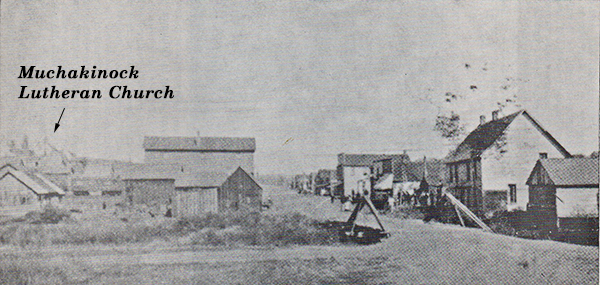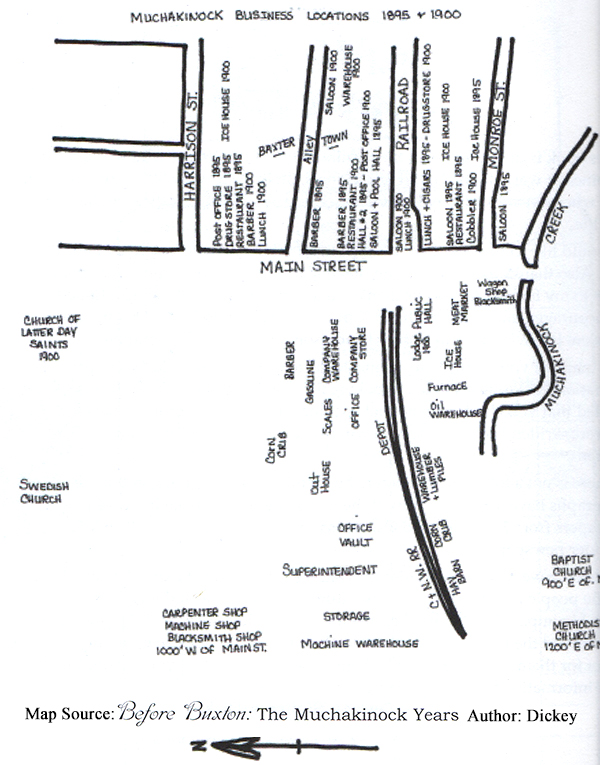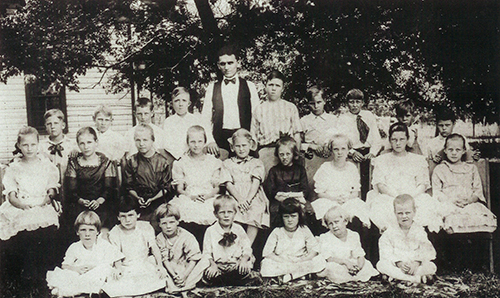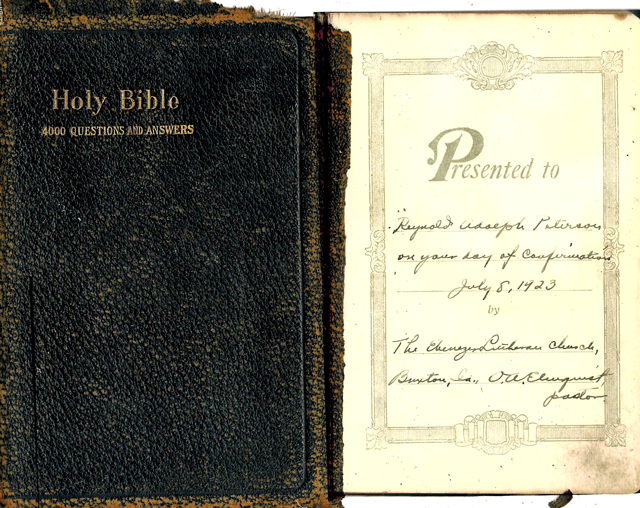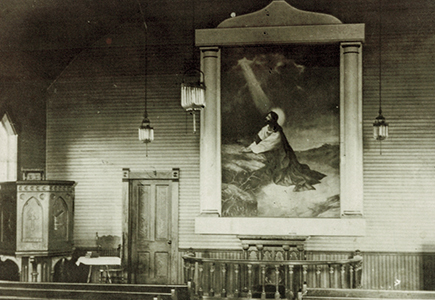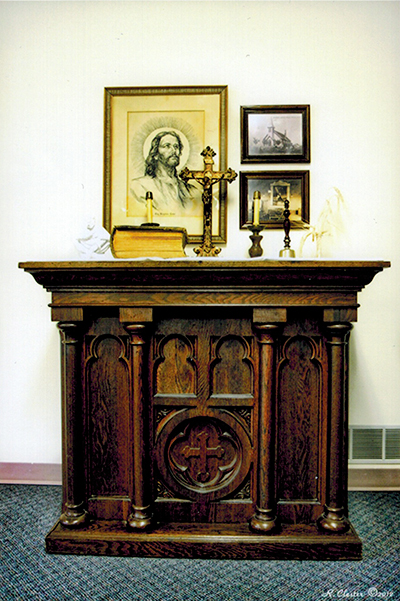
http://www.buxtoniowa.com • Consol, Haydock & Buxton Iowa, USA • 1871 - 2014
Muchakinock Lutheran Church, Early Ebenezer Lutheran Church History 1882-1901
Story from the St. Paul Lutheran Church in Albia, Iowa Anniversary Celebration Booklet.
Muchakinock Lutheran Church - Muchakinock, Iowa 1882-1901
In the late 1860s, a new coal-mining town sprung up in Mahaska County a couple of miles south of Oskaloosa. The name of the town was Muchakinock. After 1881, when the Chicago and North Western Railroad purchased the Consolidation Coal Company, Muchakinock became a boomtown — the largest unincorporated coal-mining town in Iowa. Already in the 1870s, Swedish Lutheran miners and their families had settled in Muchakinock and were meeting together for worship. Before 1882, Munterville Lutheran Church’s first pastor, Magnus Fredrik Håkanson served the Swedish Lutheran community in Muchakinock. A layman, E. Anderson also helped out. The congregation officially organized in 1882. Charter members included Carl Otto Carlson, Carl Swenson, Aron Peterson, and Mrs. Thea Dahn. Dahn’s daughter, Dina, was the first child baptized there. The congregation erected a church building in 1883. Unfortunately, the ground under the church building proved unstable because of depressions in the ground. The church had to be propped up and reinforced underneath with dirt. This still did not entirely solve the problem, and the building was later moved to a new sight a couple hundred yards west. The congregation never had its on parsonage. The congregation joined the Augustana Synod in 1884.
Ten years after its founding, the congregation’s membership stood at 200: 116 adults and 84 children. However, by 1897 the membership had dropped to 133 total members: 81 adults and 52 children. This could have been due, in part, to an extended pastoral vacancy of two to four years. With the return of a pastor in 1898, the congregation increased again to 146 total: 84 adults and 62 children. That same year, the congregation held Swedish school for six weeks. One teacher oversaw 40 students. The Sunday school that year had 50 students and 8 teachers.
In 1900, the Consolidation Coal Company moved their operations from Muchakinock to Buxton. The entire town moved too. In Buxton, the company rented new homes to many miners. However, many of the Swedish miners chose to move their homes by rail from Muchakinock to Buxton. The company paid for the transportation of the houses and provided the miners with new lots in Buxton that they could rent for fifty cents/month. The church building, too, was moved to Buxton in 1901. This move brought the Muchakinock congregation to an end. But it would be reborn in a new incarnation: Ebenezer Lutheran Church in Buxton.
Ebenezer Lutheran Church - Buxton Iowa 1902-1954
After the Swedish miners moved the Muchakinock church building to Buxton, they set about organizing a new congregation: Ebenezer Lutheran Church. On January 31, 1902, the congregation purchased a ledger book for $.50 and incorporation paper for $.30. Four days later on February 4, there is an entry in the ledger book for the recording of the congregation's incorporation. The cost of this legal transaction was $1.00. Later that same month on the 25th, the congregation made a large purchase, evidently for new furnishings, from the Grand Rapids School Furniture Works for the sum of $161.42, their largest single expenditure of the year. They purchased fire insurance October from a company in Burlington for $4.92/year. On November 14, the congregation bought a church stove for $32.85 from the mining company's general store: W.A. Wells. Thus by the end of the year, they were well settled into their new town and into their relocated building, now valued at $1,056. The congregations entire income its first year of existence was $676.44. Disbursements totaled $836.36. The membership of the congregation in 1902 stood at 1113. Its Swedish parochial school enrolled 25 children. For a large part of 1902, Pastor Anders Gunberg of Ottumwa served the congregation.
Pastor Axel Elfström, Ebenezer's first called pastor, began serving the congregation near the end of 1902. In 1903, his first full year of service in the congregation, Pr. Elfström's salary was $225. In addition to his salary, he received additional money for board, since his permanent residence and primary congregation was in Centerville. When in Buxton, he boarded with parishioners. Throughout Pastor Elfström's tenure, the congregation continued to grow, peaking in 1910 at 225 members. Unfortunately that same year, Pr. Elfström became gravely ill and died on August 16.
The congregational membership exceeded 200 persons for only an additional two years. In 1913, the membership dropped to 128. Interestingly, though, the congregation reported the highest enrollment in its Swedish parochial school in 1913: 43 students. Until 1923, the average membership of the congregation held at 135 members. However, in 1924, the membership fell to 34. This radical decline in population was likely tied to the fate of the Buxton coal mines. When the mines closed, many persons moved on to other communities. Throughout the rest of its history, the membership of the congregation remained at no more than 25-50 persons.
Until 1933, the congregation recorded all of its business in the Swedish language. Beginning that year, the treasurer began to keep the financial transactions in English. The minutes of the annual meeting continued in Swedish until 1939. That year, the congregation undertook some repairs and remodeling of the facilities; the accumulated bills for the project totaled $249.30. Throughout much of its history, the congregation had charged a set manual membership fee to all adult members of the congregation. For many years, the men’s fee was $10, and the women’s was $5. In 1944, the congregation raised the men’s fee to $15, and the women’s to $7.50. The congregation also authorized special offering at the annual meeting each year. For example, they often agreed to take an offering for their current pastor at Christmas, an offering for the organist at Easter, and an offering for the janitor at the following year’s annual meeting. They also consented to collecting various other offerings for conference or synodical causes throughout the year. Pastor Arnold Nelson attempted both in 1951 and 1952 to convince the congregation to begin using offering envelops. Whether or not they made a change remains unclear.
Ebenezer Lutheran Church of buxton has a couple of interesting claims to fame. Pr. P. O. Bersell of Ottumwa served as their pastor on two separate occasions: 1914- 1916 and 1927-1935. Beryl was later elected to serve as the ninth president of the Augustana Lutheran Church, a post he held from 1935 to 1951. Likewise, Pr. Malvin Lundeen of Ottawa, also served the Buxton congregation twice: 1944-48 and again in 1949. He, too, was elected to serve as president of the Augustana Lutheran Church from 1959-62. He was the last person to serve in that office. Signe Larson was a famous daughter of the congregation. Deaf from birth, she became a renowned artist throughout the Midwest and across the country. She attended Bethany College after leaving Buxton and received her degree in 1933. She studied at numerous other art schools and institutes, and won a number of prizes for her work. Her most famous painting is the picture of Christ entitles, “Thy Kingdom Come.” Three reproductions of her work are currently displayed in the fellowship hall of St. Paul’s Lutheran Church in Albia.
In 1952, the congregation celebrated its 50th anniversary. Over 125 persons attended the festivities. Dr. Malvin Lundeen was the guest preacher for the day. The choir from Munterville Lutheran Church ended their voices to the program, and Linus Larson offered a recitation of the congregation’s history. In the year of the golden anniversary, the congregation’s average attendance in worship was only 26 persons. In his handwritten report to the annual meeting of the congregation on January 19, 1953, Pr. Nelson strongly encouraged parishioners to purchase lightning rods for the building, lest the church catch fire. “God has spared us from our sins; we have escaped the fire of lightning,” he wrote. “Let us this year get lightning rods without fail.” Strangely enough, the church would burn down in less than two years. However, the culprit wasn’t lightning; it was the church stove.
On Monday December 20, 1954, the Sunday School children and their teachers were practicing for the Christmas program, entitled “The Lights of Christmas.” The performance was to be the next evening. Being a cool afternoon, they had lit a fire in the stove to keep themselves warm. At one point in the rehearsal, one of the teachers thought she noticed a flash near the ceiling next to the stovepipe, but she ignored it, assuming it was a glare from the lights. Having finished the program, the children proceeded outside, only to notice that the church was in flames. The stovepipe had caught fire in the ceiling and roof. Although the Albia fire department responded, they were unable to save the building. Some neighbors who arrived on the scene were able to get the altar, the piano, the organ, and the pews, among other things, out of the structure. The most tragic loss was the large altar painting of Christ praying in the Garden of Gethsemane. Painted by Birger Sandzen, the artwork was valued at the time around $2,500. The painting is visible in the picture above. Soon thereafter, the congregation decided to merge with St. Paul’s Lutheran Church of Albia.
The altar that was saved from the Buxton fire now stands in the fellowship hall of St. Paul’s Lutheran Church in Albia, along with a number of other accessories from the earlier congregation. They serve as on-going reminders of Ebenezer’s continuing legacy within St. Paul’s.
Pastors
Magnus Fredrik Håkanson
Martin Patricius Oden (1882-1889)
Eric Jonas Nyström (1892-1896)
Sven Gustaf Youngert (1898-1899)
Axel Walfrid Petrus Elfström (1902-1910)
David Natanael Anderson (1910-1913)
Petrus Olof Bersell (1914-1916)
Andrew John Berghult (1917-1919)
Oscar Aron Landell (1920)
Bert Martin Samuelson (1920-1921)
Carl August Johnson (1921-?)
Johannes Nelson Almquist (?)
Frank E. Peterson (1924)
Petrus Olof Bersell (1927-1935)
Carl Sigfrid Ericson (1936)
Pastor Elmer Frank Sahlgren (1937-1941)
Johan Gabriel Swedberg (1943)
Malvin Hjalmar Lundeen (1944-48)
Carl Edward Cederberg (1948)
Malvin Hjalmer Lundeen (1949)
Nevin Eugene Larson (1949)
Arnold Hjalmer Nelson (1950-54)
